Hi Everyone
Need some help and your opinions please?
We have been losing our LPS steadily over the last few months and I am tearing my hair out now looking for a reason. We have lost nearly all our euphyllia starting with a wall frogspawn a few months back, followed by a 5 head green hammer about 6 weeks ago, a 3 head blue tip torch which the polyps bailed recently out of over a 2 day period (was apparently perfectly healthy up to a day or so before) and now the final straw a lovely wall purple hammer is receding. All these were added around the same time over a 2 month period which was about March-April this year - so about 6-7 months ago. Most were healthy and looked great until a few months back - we lost a goni first (BJD), the frogspawn followed soon after (no BJD). We also lost an elegance that only lasted a few weeks but I understand that is a common occurrence.
In addition it appears we have begun a new phase of either diatoms or dinos. Tank is 11 months since first fish. We battled cyano in Feb-March this year and beat it down by vacuuming the sand fortnightly. I am attaching some of photos and my 2 ICP tests which I ran at the same time (quite recently). The ATI ICP also includes the RO water which came back spotless. I've got some close-up videos of the montis both in good health and more recently as well and I may upload them to YT and link them if there is interest.
My salt mixing barrel in the garage has been also developing a brown seemingly bacterial scum on the water even though last time it was empty I cleaned it with a hydrogen peroxide solution. This happened before but over a much longer period (several months between cleaning) - whereas this last time I have only made 2 batches i think and the brown spots/surface scum seems much worse than it was before. I don't think this is the same as what we are seeing in the DT but I would still rather have crystal clear water to put in. I'll tip what I have now and clean the barrel before adding any more water. The water we added last week looked alot cleaner than how it appears now (just a few days later).
Some (well let's face it basically all) of our SPS are also unable to survive our efforts. We have apparently lost: an orange plating monti, several cyphastrea, and the latest ones to go downhill were an encrusting monti (was green with orange polyps) another monti (had nice blue polyps) and a green psammocora - this one is still with us but developed brown lines and is heading south as well. The (beautiful) mummies eye chalice which you see our Starry Blenny 'Astrid' admiring was stung by one of our anemones and receded all the way to infinity - so that one I can explain myself.
It appears to me (though I could be wrong) that the brown dust/mud/algae which I am constantly cleaning off the glass and appears to be collecting on the substrate ends up covering them and there is nothing to sweep it away. Even if I go in and blow with a turkey baster it does not budge - it's like it is growing on the coral skeleton. Eventually everything just ends up brown and dead.
Flow is 2xMP40s and a Maxspect xf-350 gyre - all up at the weir end of the tank - it's a peninsula so all equipment is located at the weir end.
We vacuumed the sand on Friday last week and combined that with a 20% wc. A few days before that we did try running an in-line pump with a filter sock to try and clean the sand in-situ but that jut stirred the sand up and clouded the tank. The blue tip torch bailed out a couple of days after that. We see a lot of small bubbles forming on the brown 'mud' on the substrate which I am assuming is some form of gas by-product of the decomposition of whatever it is - or perhaps as a result of photosynthetic activity? Most notably when magnet cleaning the glass - a lot of the bubbles are disturbed. This gas is a relatively recent thing.
My current tank parameters and history are available in this link along with hardware and fish/invert stocking list AquaticLog Rocks!:
 www.aquaticlog.com
www.aquaticlog.com
If you can't see params etc. via the link pls let me know - here are the latest readings.

The substrate is 50/50 caribesa special grade/fuji pink with some coarse crushed coral mixed in. The rock is Caribsea life rock shapes. My ICP shows elevated silicates, and Aluminium although the 2 tests disagree on how much Al is in there. I am using ceramic bio media extensively in the sump - probably caused the elevated Al readings. (1 x marinepure 8x4x4 brick, 1 x mp 8x1x1 plate and 1 x Brightwell Aquatics NO3 brick).
Please help! We are losing confidence and have now decided not to buy any more coral until we understand what is going on. The only glimmer of good news is all the fish seem healthy and are growing.
I do run a 36w Helix 2.0 UV and our Magnificent Foxface (Vivian) has had some ich (just a few spots now and then) which seems to be being beaten down by it. I was worried perhaps I have encouraged a bacterial imbalance in the tank by running UV relatively slowly to try and combat the ich threat but I have no idea if this is even a thing. The UV is running at about 750 litres/hour which is approx 1x tank turnover.
I'm sorry for the long post but I do hope someone out there can help us - I may resort to buying a microscope to try and identify the brown sludge. There is an assortment of wider field tank shots - some taken just after the last sand vacuuming and some just now about 5 days later to show how it has come back.
If more shots required I can provide!
Cheers

Frogspawn on the way out.
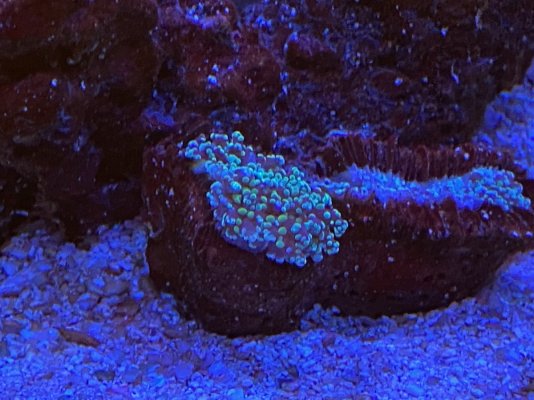
A green torch I forgot to mention - now also gone
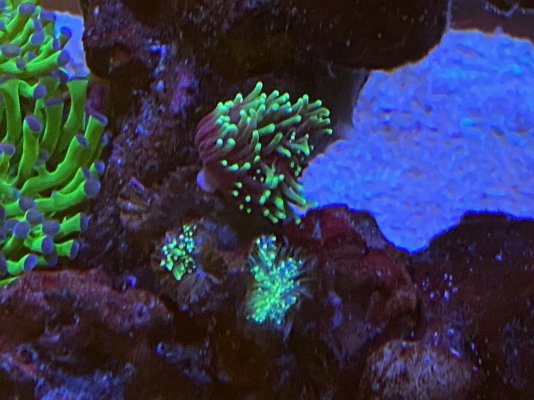
The green hammer - gone
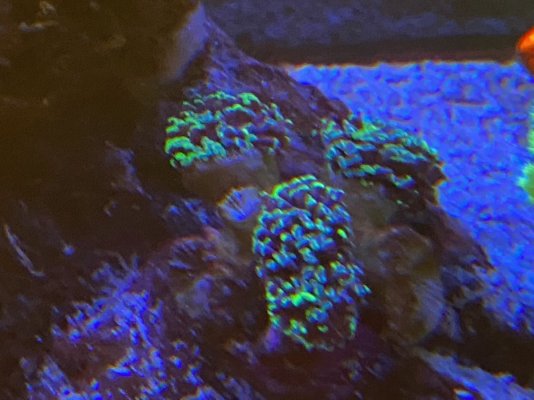
Purple wall hammer before major demise began.
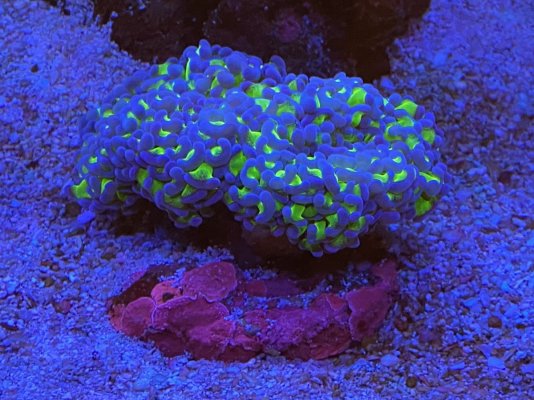
Chalice post anemone sting - now gone.
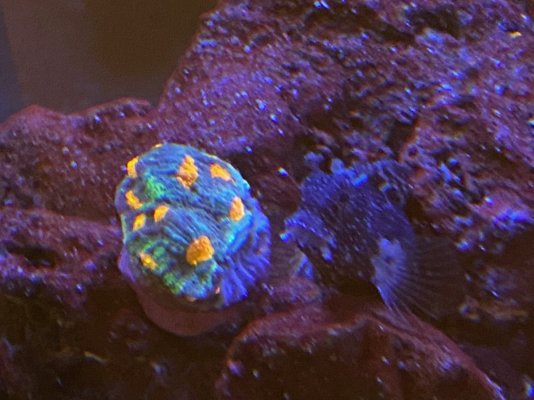
2 montis seem to be bleaching
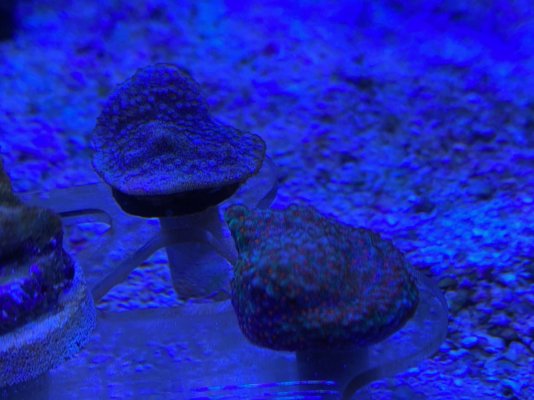
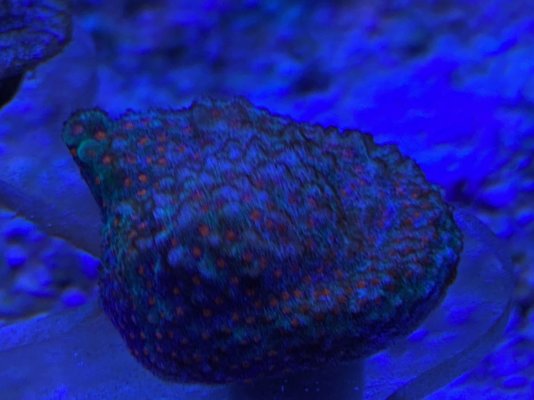
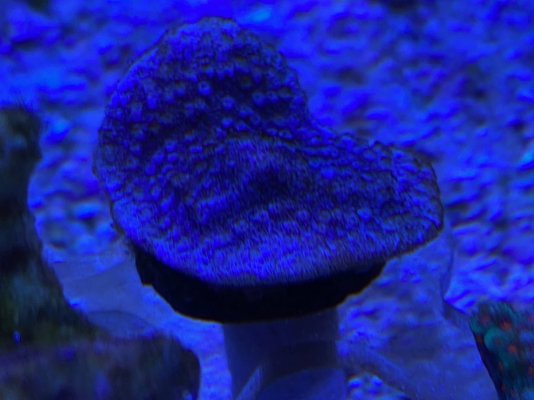
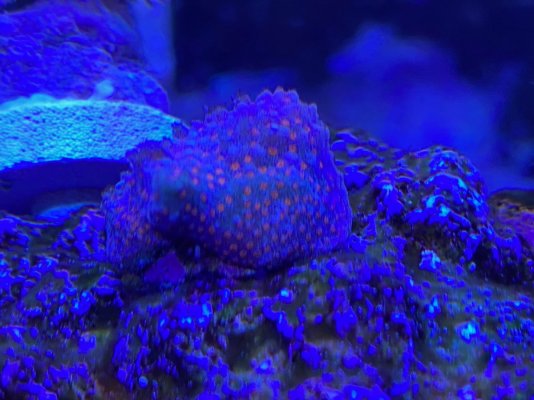
Blue tip torch bailing out - now all polyps gone.
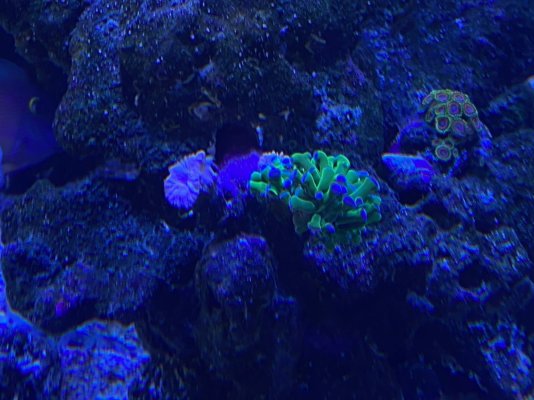
We always see these when we dip - after corals have been in the tank - any ideas - good/bad?
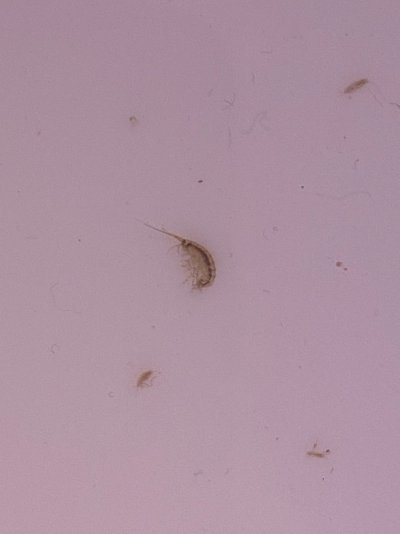
Some shots after the last sand vacuuming - last week
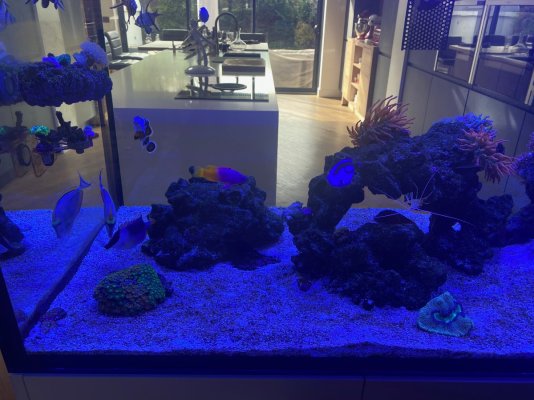
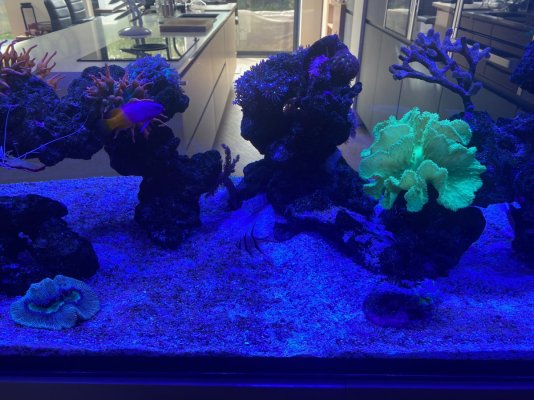
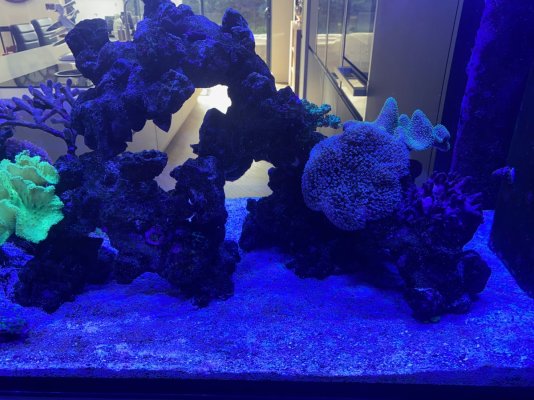
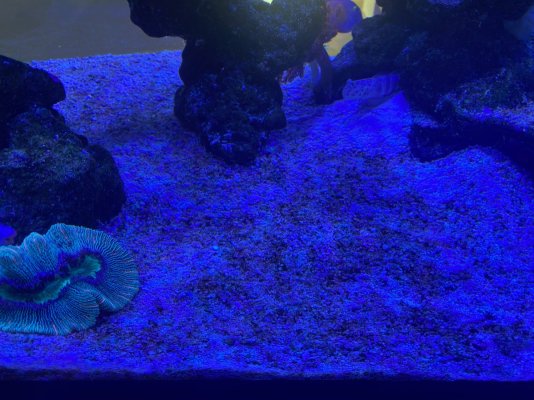
And 5 days later...
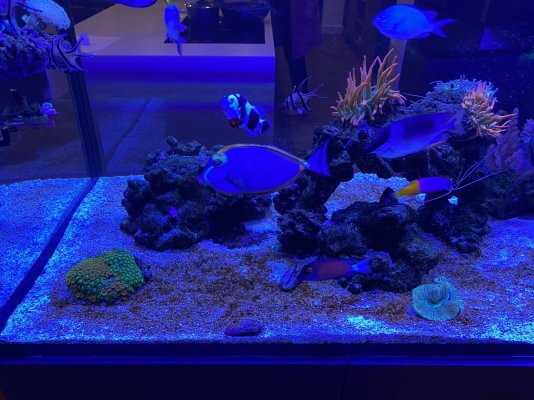
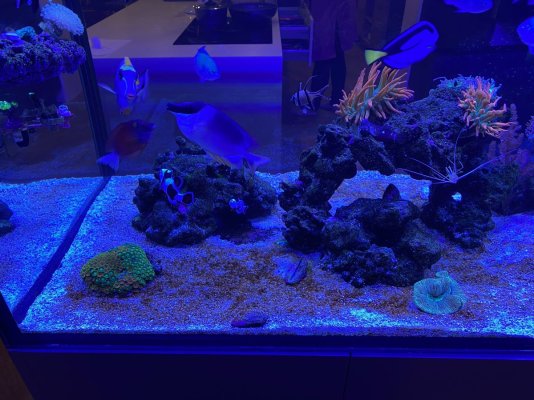
Purple wall hammer is now looking like this (bottom right).
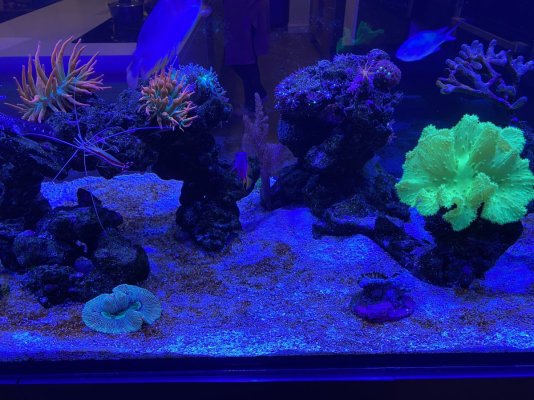
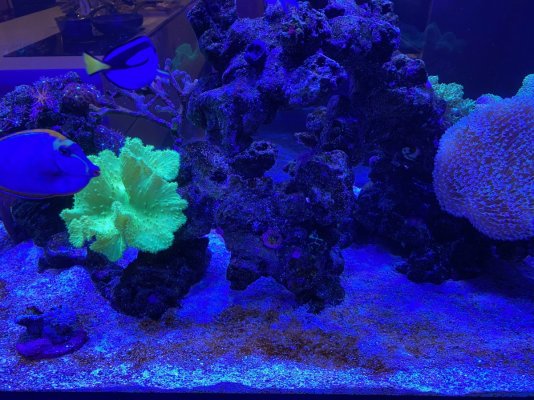
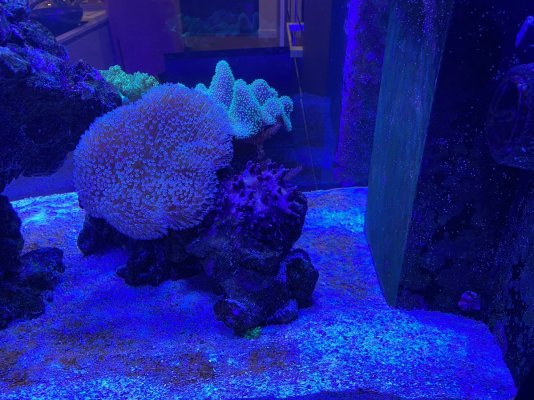
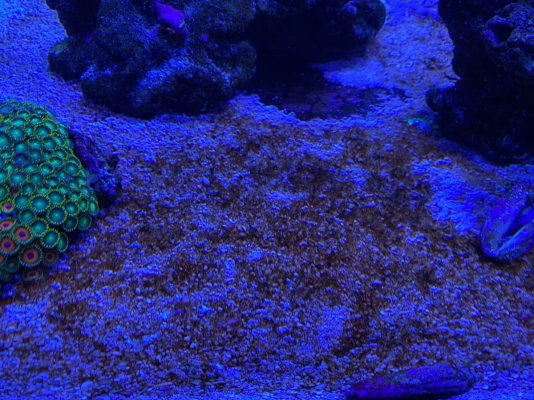
Need some help and your opinions please?
We have been losing our LPS steadily over the last few months and I am tearing my hair out now looking for a reason. We have lost nearly all our euphyllia starting with a wall frogspawn a few months back, followed by a 5 head green hammer about 6 weeks ago, a 3 head blue tip torch which the polyps bailed recently out of over a 2 day period (was apparently perfectly healthy up to a day or so before) and now the final straw a lovely wall purple hammer is receding. All these were added around the same time over a 2 month period which was about March-April this year - so about 6-7 months ago. Most were healthy and looked great until a few months back - we lost a goni first (BJD), the frogspawn followed soon after (no BJD). We also lost an elegance that only lasted a few weeks but I understand that is a common occurrence.
In addition it appears we have begun a new phase of either diatoms or dinos. Tank is 11 months since first fish. We battled cyano in Feb-March this year and beat it down by vacuuming the sand fortnightly. I am attaching some of photos and my 2 ICP tests which I ran at the same time (quite recently). The ATI ICP also includes the RO water which came back spotless. I've got some close-up videos of the montis both in good health and more recently as well and I may upload them to YT and link them if there is interest.
My salt mixing barrel in the garage has been also developing a brown seemingly bacterial scum on the water even though last time it was empty I cleaned it with a hydrogen peroxide solution. This happened before but over a much longer period (several months between cleaning) - whereas this last time I have only made 2 batches i think and the brown spots/surface scum seems much worse than it was before. I don't think this is the same as what we are seeing in the DT but I would still rather have crystal clear water to put in. I'll tip what I have now and clean the barrel before adding any more water. The water we added last week looked alot cleaner than how it appears now (just a few days later).
Some (well let's face it basically all) of our SPS are also unable to survive our efforts. We have apparently lost: an orange plating monti, several cyphastrea, and the latest ones to go downhill were an encrusting monti (was green with orange polyps) another monti (had nice blue polyps) and a green psammocora - this one is still with us but developed brown lines and is heading south as well. The (beautiful) mummies eye chalice which you see our Starry Blenny 'Astrid' admiring was stung by one of our anemones and receded all the way to infinity - so that one I can explain myself.
It appears to me (though I could be wrong) that the brown dust/mud/algae which I am constantly cleaning off the glass and appears to be collecting on the substrate ends up covering them and there is nothing to sweep it away. Even if I go in and blow with a turkey baster it does not budge - it's like it is growing on the coral skeleton. Eventually everything just ends up brown and dead.
Flow is 2xMP40s and a Maxspect xf-350 gyre - all up at the weir end of the tank - it's a peninsula so all equipment is located at the weir end.
We vacuumed the sand on Friday last week and combined that with a 20% wc. A few days before that we did try running an in-line pump with a filter sock to try and clean the sand in-situ but that jut stirred the sand up and clouded the tank. The blue tip torch bailed out a couple of days after that. We see a lot of small bubbles forming on the brown 'mud' on the substrate which I am assuming is some form of gas by-product of the decomposition of whatever it is - or perhaps as a result of photosynthetic activity? Most notably when magnet cleaning the glass - a lot of the bubbles are disturbed. This gas is a relatively recent thing.
My current tank parameters and history are available in this link along with hardware and fish/invert stocking list AquaticLog Rocks!:
Main Tank's Parameters
If you can't see params etc. via the link pls let me know - here are the latest readings.
The substrate is 50/50 caribesa special grade/fuji pink with some coarse crushed coral mixed in. The rock is Caribsea life rock shapes. My ICP shows elevated silicates, and Aluminium although the 2 tests disagree on how much Al is in there. I am using ceramic bio media extensively in the sump - probably caused the elevated Al readings. (1 x marinepure 8x4x4 brick, 1 x mp 8x1x1 plate and 1 x Brightwell Aquatics NO3 brick).
Please help! We are losing confidence and have now decided not to buy any more coral until we understand what is going on. The only glimmer of good news is all the fish seem healthy and are growing.
I do run a 36w Helix 2.0 UV and our Magnificent Foxface (Vivian) has had some ich (just a few spots now and then) which seems to be being beaten down by it. I was worried perhaps I have encouraged a bacterial imbalance in the tank by running UV relatively slowly to try and combat the ich threat but I have no idea if this is even a thing. The UV is running at about 750 litres/hour which is approx 1x tank turnover.
I'm sorry for the long post but I do hope someone out there can help us - I may resort to buying a microscope to try and identify the brown sludge. There is an assortment of wider field tank shots - some taken just after the last sand vacuuming and some just now about 5 days later to show how it has come back.
If more shots required I can provide!
Cheers

Frogspawn on the way out.

A green torch I forgot to mention - now also gone

The green hammer - gone

Purple wall hammer before major demise began.

Chalice post anemone sting - now gone.

2 montis seem to be bleaching




Blue tip torch bailing out - now all polyps gone.

We always see these when we dip - after corals have been in the tank - any ideas - good/bad?

Some shots after the last sand vacuuming - last week




And 5 days later...


Purple wall hammer is now looking like this (bottom right).




Attachments
Last edited:




















